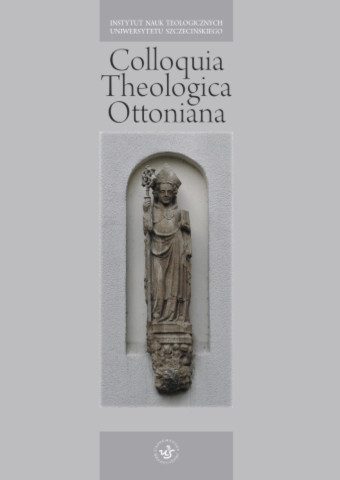
ISSN: 1731-0555
eISSN: 2353-2998
OAI
DOI: 10.18276/cto.2017.2-06




Issue archive /
2/2017
Nawroty brzmieniowe w ewangelii wg św. Marka w kilku nowszych przekładach wersetów 33-50 z rozdziału 9
(The wording recurence in the gospel according to st. Mark in several newer translations of verses 33-50 form chapter 9)
| Authors: |
Grzegorz
Kubski
Wydział Pedagogiczno-Artystyczny UAM w Kaliszu Uniwersytet Adama Mickiewicza, Poznań |
| Keywords: | Gospel of St. Mark Mark 9 33–50 translations rhetoric euphony figures of the group of geminatio |
| Data publikacji całości: | 2017 |
| Page range: | 23 (103-125) |
Abstract
Newer translations of the Gospel according to St. Mark into the Polish language - as well as translations of other books of the Holy Bible - are characterized by a significant reduction of the use of an measures adopted in our culture as a style of biblical, though in varying degrees. In many cases, such measures are fully translatable into the Polish language - e.g. polysyndetic coordination from καὶ . The text of St. Mark uses relatively narrow vocabulary and frequent recurrence of the same expressions. They serve for a clearer arrangement of voicings, the euphony marks subtle literary composition of pericopes. Literary composition of the Gospel of St. Mark is being emphasized by the exploitation of the broad possibilities of semantic and aesthetic use of figures of words per adiectionem, especially the figures of the group widely understood geminatio. In this article detailed classification of these figures is treated cursorily, and main focus is on the compositional (disposable) and the literary consequences of their use in a part of text of 9,33-50 (it can be considered as an independent pericope). The article is the result of a comparison of pericope 9, 33-50 translations by Roman Brandstaetter, Marian Wolniewicz, Czesław Miłosz, Franciszek Sieg SJ, and specified in the fifth edition of the Millennium Bible, and the Paulines Bible. Four of these translators are also a poets. Attention was pointed to the varying degree of respecting of polysyndetic coordination from καὶ and the recurrence of words and phrases, such as. «On the way», «in My name», «accepts», «reason of sin,» «throw», «fire» and the role of antonymy «dispute» and «keep the peace». It turned out that in maintaining euphony of Brandstaetter’s translation healso used the sonic possibilities verses rhyme, which he wrote out the text according to the colometric system. He approached in this way to the construction of versification. The presence of the traditional features of the Polish language in these Bible translations was also noted - respected in varying degrees. Undoubtedly, those translators who also have a poetic legacy, broadly taken into account the aesthetic potential of euphony.
Download file
Article file
Bibliography
| 1. | Bartnicki R., Ewangelie synoptyczne. Geneza i interpretacja, Warszawa 2003. |
| 2. | Brandstaetter R., Księgi Nowego Przymierza. Przekłady biblijne z języka greckiego, Kraków 2004. |
| 3. | Chmiel J., Interpretacja Starego Testamentu w kerygmacie apostolskim o zmartwychwstaniu Jezusa. Studium hermeneutyczne, Kraków 1979. |
| 4. | Czerski J., Ewangelie synoptyczne. W aspekcie literackim, historycznym i teologicznym, Opole 1996. |
| 5. | Ewangelia według Marka, tłum. C. Miłosz, Poznań 1981. |
| 6. | Ewangelia według św. Marka, tłum. F. Sieg, Warszawa 2014. |
| 7. | Godyń J., Wstęp, w: tenże, Od Adama i Ewy zaczynać. Mały słownik biblizmów języka polskiego, Kraków–Warszawa 1995. |
| 8. | Grecko-polski Nowy Testament, tłum. R. Popowski, M. Wojciechowski, Warszawa 1993. |
| 9. | Gutt E.-A., Dystans kulturowy a przekład, tłum. A. Pokojska, Kraków 2004. |
| 10. | Kantor M., Struktury dośrodkowe i odśrodkowe w poezji biblijnej. Ps 120–134, Kraków 1998. |
| 11. | Koziara S., Polszczyzna biblijna w poszukiwaniu wzorca stylowego (doświadczenia i współczesność), w: Polszczyzna biblijna. Między tradycją a współczesnością, red. S. Koziara, W. Przyczyna, t. 1, Tarnów 2009. |
| 12. | Lausberg H., Retoryka literacka. Podstawy wiedzy o literaturze, tłum. A. Gorzkowski, Bydgoszcz 2002. |
| 13. | Matuszczyk B., O potrzebie modernizacji języka religijnego w przekładach biblijnych, w: Polszczyzna biblijna. Między tradycją a współczesnością, red. S. Koziara, W. Przyczyna, t. 2, Tarnów 2009. |
| 14. | Meynet R., Język przypowieści biblijnych, tłum. A. Wałęcki, Kraków 2005. |
| 15. | Mędala S., Ewangelia według świętego Jana. Rozdziały 1–12, Częstochowa 2010. |
| 16. | Nida E.A., Language Structure and Translation. Essays…, California 1975. |
| 17. | Paciorek A., Ewangelia według świętego Mateusza. Rozdziały 1–13, Częstochowa 2004. |
| 18. | Paciorek A., Ewangelia według świętego Mateusza. Rozdziały 14–28, Częstochowa 2008. |
| 19. | Pawelec A., Anafora a przekład, w: Mała encyklopedia przekładoznawstwa, red. U. Dąmbska-Prokop, Częstochowa 2000. |
| 20. | Pismo Święte Nowego Testamentu, Poznań 1984. |
| 21. | Pismo Święte Starego i Nowego Testamentu, Częstochowa 2008. |
| 22. | Pismo Święte Starego i Nowego Testamentu, Poznań 2000. |
| 23. | Popowski R., καὶ , w: tenże, Wielki słownik grecko-polski Nowego Testamentu, Warszawa 1995. |
| 24. | The Greek New Testament, red. K. Aland, M. Black i in., Stuttgart 1975. |
| 25. | Ziomek J., Retoryka opisowa, Wrocław–Warszawa 1990. |